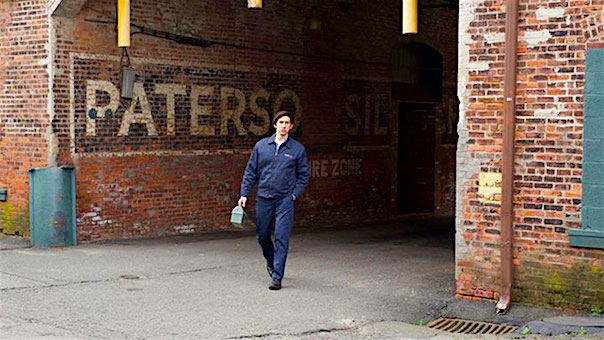by Igor Salutregi Gagiola
What is life? Whoever tries to answer this question, will face several problems to determine it, because it is not an easy task, and to define it in a film is even harder. But Jim Jarmusch has achieved this issue with the notable Paterson. If his last fiction Only Lovers Left Alive (2013) was a film about Death -or better said, about immortality- this new film is utterly about Life. One of the characteristics of Jarmusch is that he chooses some objects that beforehand can appear banal, vain, with lack of drama, and then he gives them deep meanings using repetition.
In Paterson, Jarmusch adds another concept to this particular use of repetition: routine. This story relates to Paterson’s life in an entire week. Every day he wakes up at the same time, he looks at his watch to ensure he is on time, and then kisses his beloved, Laura, who lies next to him placidly asleep. Then, he has breakfast turning back on the pet of the house: Marvin, Laura´s bulldog, which, although he takes it for a walk everyday, doesn´t please Paterson. After that, he leaves home to complete an eight hours work-day driving a public bus, which is filled with people´s different routines and quotidian matters.
But, what takes him out of this routine, out of this monotony, is in the same way the action that comprehends the entire beauty of his life: writing poetry. Paterson writes poetry. He loves it, and he uses every second he is not immersed in duties to write it. And what does he write about? About life, mundane life he enjoys every day, at least feels comfortable, and uses poetry to rise towards “mysticism”. On the bus, in the park, at home. Paterson puts single words together to create beauty, the beauty of life, because in this film, if something is captured is the beauty of quotidian things. For Paterson, a simple box of matches is enough to write poetry because he can see beyond objects. For him, his girlfriend is a princess, the conversations of passengers are funny stories, and the life captured by the windows of the bus he drives are beautiful.
Jarmusch uses camera-movement to portrait life; or, even better said, to portrait life´s poetry. He distinguishes difference between life at home, and life outside. At home, the only thing that breaks the routine is Laura, who has neither a regular life nor a regular job, so she can spend the day painting curtains as well as buying a guitar and starting to play and learn from tutorials. To express this, the American director uses static-shots and indiscernible camera-movements. But, as for Paterson life starts on the street, where he is inspired by the beauty of life, once outside, the camera moves with him as his brain begins his own movement, elaborating ideas that, in the end, will be put into words, creating poetry.
Jarmusch has achieved to express Life in it’s real tempo, but he also has managed to turn routine and boredom into beauty.
Video courtesy of: Bleecker Street
[imdb id=tt5247022]











